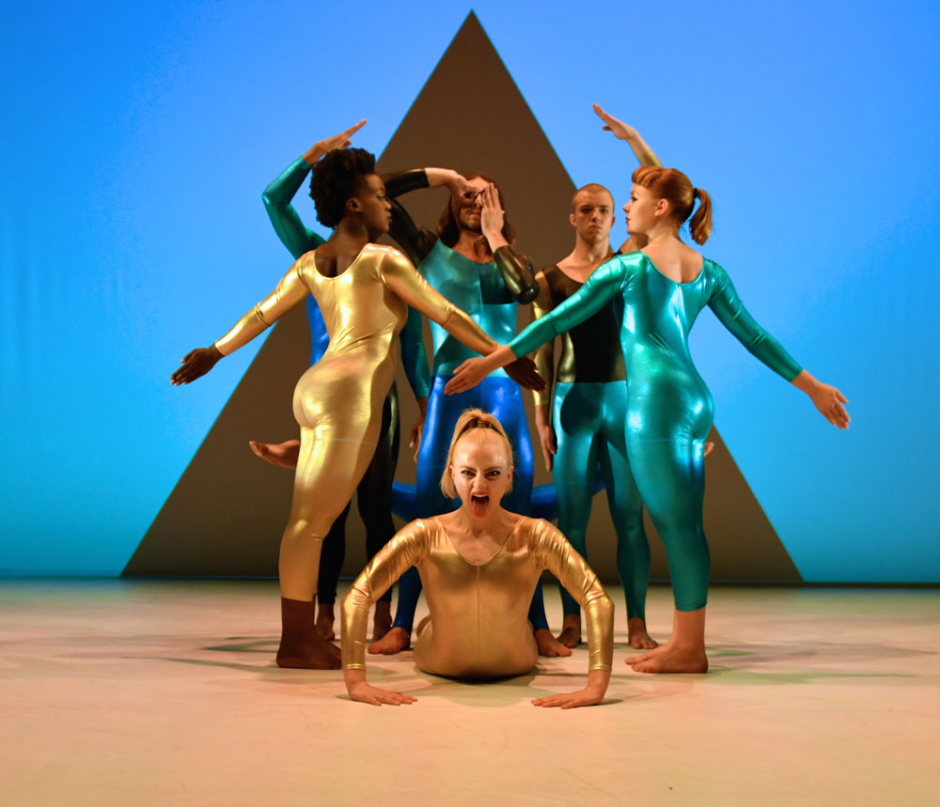MK Ultra, directed by Rosie Kay, HOME, May 3 2017.
From its opening declaration, ‘This is Fake Theatre’, it is clear that MK Ultra is a performance that intends to challenges the notion of truth and its role in modern media. Taking its name from a mind control programme developed by the CIA in the 1950s, the show uses a documentary created by acclaimed film-maker Adam Curtis to detail the history of this political project. As the film’s narrative explains the creation of pseudo-religion known as Discordianism and the emergence of conspiracy theories about the Illuminati, the story becomes an appropriately bizarre springboard for questions about the nature of belief in the modern world to be interrogated through contemporary dance. Curtis employs a range of documentary techniques such as interviews and voice-overs to keep the performance focused on the specific historical phenomenon, while the dance choreographed by Rosie Kay imaginatively interprets the underlying issues. Binaries including order and chaos, free will and determinism, and reality and fantasy are all examined through the dancers’ partially ecstatic and generally sinister movements.
Through a fusion of contemporary, ballet, street, and hip hop, the dancers display the sense of subjugation articulated by the victims of MK Ultra in the video interviews. Intensely sexualised dancing frequently appeared alongside Disney iconography to portray a loss of innocence and to depict society’s regression to innate animalism. The dancers’ vivid facial expressions oscillated between gormless oblivion and extreme mania, indicating the darker side of rave culture.
The most frequent arrangement of dancing was in a trio. Groups of three appear throughout the performance, mirroring the three points of the screen in the backdrop and serving as a constant reminder of the Illumanti symbol of the triangle. However, the most effective sequences are the group pieces. When the dancers come together, the mechanisation of their movements is pushed to its extreme. Disjointed limbs interlock to display a ghastly automaton which expands and contracts as if controlled by the pulsating rhythm. As the audience struggle to see where one body ended and the next begins, they understand the implied consequences of a media driven society. In these moments, where the dancers are denied their individuality, they also quickly appear to lose their humanity.
Whilst both the dance and the film were highly compelling, they were somewhat let down by the integration of these elements. The psychedelic visuals of Curtis’ film undoubtedly match the dancers’ phantasmagorical cat suits, and illuminati symbols appear in both, but at times, these elements seemed to complete rather than to complement each other. More than once I felt that the dance distracted from the video footage, and was sometimes left wanting to see more of Curtis’ hypnotic film. A more intricate weaving of the music score and the film’s audio might have helped to achieve a smoother integration.
The performance closes with a dystopian Disney-style ending. Desperation seeps out from the dancers’ faces, which appear to be fixed on the audience with whom they are attempting to make a connection. Their fragmented movements to the music of Pinocchio’s ‘When you Wish Upon a Star’, effectively articulate the sinister undertones of mass media fantasies.
MK Ultra is an incredibly timely performance which employs an intriguing political subject as the inspiration for an innovative piece of contemporary dance. Throughout the piece, film and dance are both used to distort reality to the point of absurdity, raising questions about the nature of truth and belief in the modern day. Whilst highlighting the fallacy of the conspiracy theories surrounding the CIA project, Kay and Curtis display the logic of the hysterical thinking in which these beliefs were formed, and in doing so, they create their own ‘Operation Mindfuck’.
MK Ultra is currently touring
.

